Top 20 Best AI Code Generator Tools [2025 Updated List]
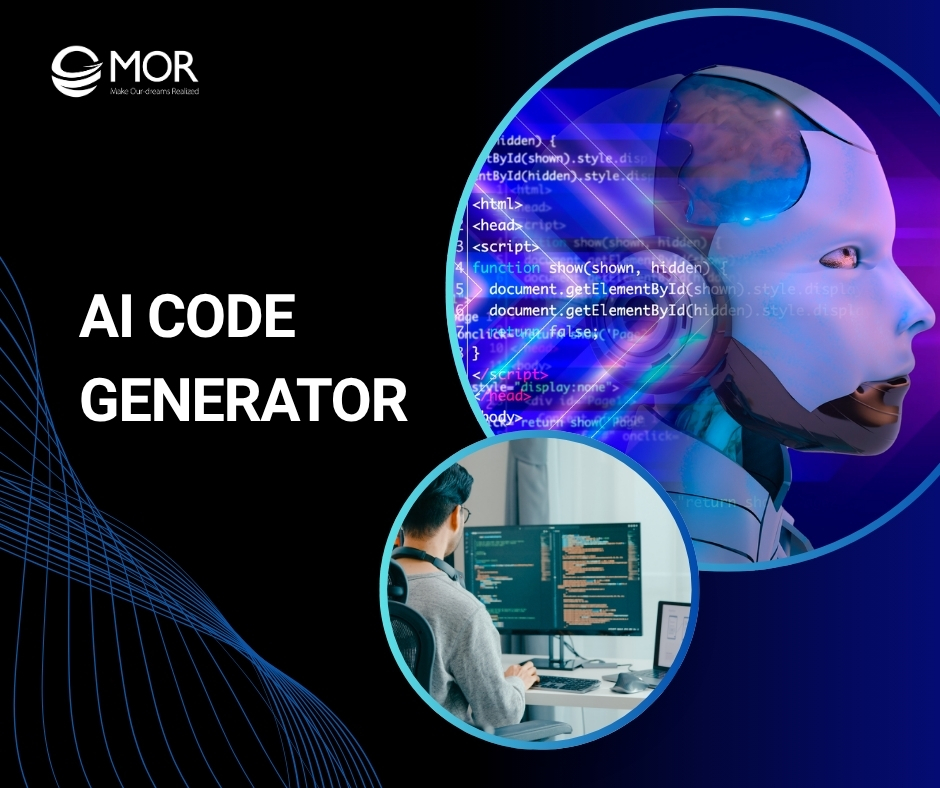
AI-driven development is reshaping how teams write and review code, boosting speed, accuracy, and consistency. But with countless tools on the market, finding the right AI code generator for enterprise use isn’t easy. This MOR Software’s guide will help you explore the top platforms that bring intelligent automation, seamless integration, and scalable performance to modern software teams.
What Is An AI Code Generator?
An AI code generator is a smart coding assistant that uses machine learning or large language models to turn plain text or existing code into working programs. Instead of writing every line manually, you describe what you need, and the tool builds it for you. It can create code snippets, full functions, UI components, tests, or even complete software features.
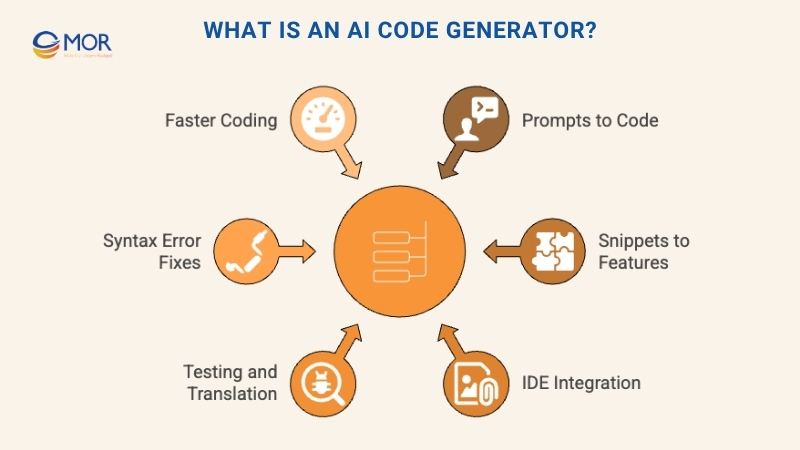
For instance:
- You could say, “Build a React component that displays a user list, fetches data from /api/users, and shows loading and error messages.” The AI code generator instantly writes the code.
- It can also write tests, translate code between programming languages, or fix syntax errors.
- Many of these machine learning models now live inside modern IDEs, so you can request or edit code right within your usual workflow.
Through combining automation with context awareness, AI code generation tools help developers code faster, stay consistent, and focus on creative problem-solving instead of repetitive typing.
How Does AI Code Generator Work?
Behind every AI code generator lies a mix of machine learning, natural language processing, and pattern recognition. These systems are trained to understand both programming syntax and the way developers describe problems in plain language. Once trained, they can interpret prompts, predict the right code structures, and generate usable outputs that match intent and context.
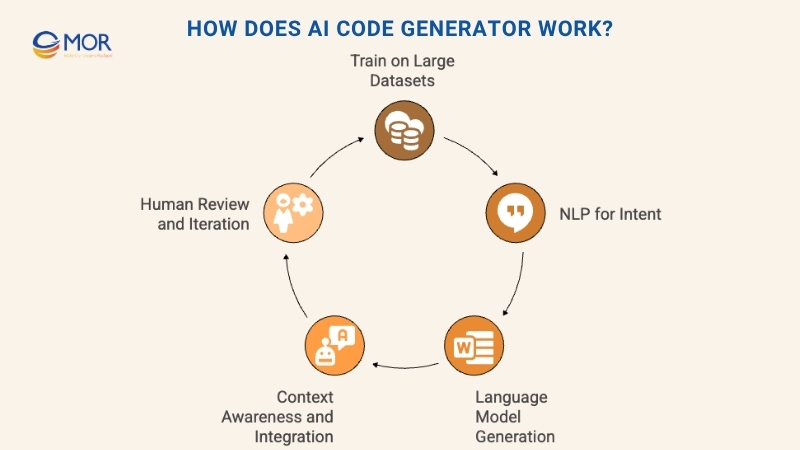
Training on Large-Scale Code and Text Data
The foundation of every code generation AI model is its training data. These models learn from billions of lines of open-source code, technical documentation, and developer comments. This process helps them understand syntax rules, logic structures, and how programmers naturally describe coding tasks.
For instance, when a user says “sort the list of users by age,” the model already knows it needs to apply a sort function, define a comparator, and return a properly ordered list. This understanding comes from recognizing patterns across countless examples gathered from real repositories and developer forums.
Natural Language Processing (NLP) to Interpret User Intent
Once trained, the system uses Natural Language Processing tools (NLP) to interpret what the developer is asking for. When you type something like “create a React component that fetches data from /api/users and displays it with loading and error states,” the AI python code generator analyzes each phrase to identify the task type, programming language, framework, and user expectations.
It then translates that plain-text instruction into a structured internal command the AI code generator can execute, turning human intent into clean, functional code.
Code Generation via a Language Model
Once the user’s intent is understood, the AI code generator relies on a large language model (LLM) or a specialized coding model to produce the actual code. Models like Codex or Gemini analyze both the prompt and the existing project context, including naming patterns and surrounding files, before generating output.
The AI code creator can write code line by line, complete an unfinished block, or even revise existing functions. Some models feature “infilling,” which means they detect missing parts inside a file and generate only what’s needed without overwriting valid code. This process depends on probability patterns the model learned during training, predicting what tokens or structures logically follow based on prior examples.
Context Awareness and Integration
Modern AI code generators don’t just spit out random code. They actively adapt to your codebase, reading your imports, file structure, AI agent frameworks, and naming conventions to keep the generated code consistent. High-end code AI generator tools also recognize style guides, internal policies, or security requirements set by your organization, ensuring every output fits into existing workflows without breaking rules.
Aligning with your project’s structure, these AI code generation tools help maintain readability, security, and standardization while making development faster and cleaner.
Human Review and Iteration
Even the best AI code generator needs a human touch. While the system can produce clean and functional code, it’s not always perfect. Developers still have to review, test, and adjust what the AI creates to match their architecture, coding standards, and performance goals. The generated code might run, but it may not be the most efficient or secure without review.
Most teams treat AI code generation as a starting point. They refine the output, tweak the prompts, or request improvements until the code aligns with their needs. This human-in-the-loop process ensures quality and keeps creativity where it belongs, with the developer.
A Step-By-Step Workflow Example
Here’s what a typical AI program generator workflow looks like in action:
- User writes a prompt: “Build a Python function that takes a list of integers and returns the top 3 most frequent numbers with their counts.”
- The tool analyzes the prompt, identifying the language (Python), data type (list of integers), and expected result (top three frequent values).
- The tool checks context: it reads that the project runs Python 3.10, uses typing, and follows Google-style docstrings.
- The tool writes the function:
from collections import Counter
from typing import List, Tuple
def top_three_frequent(nums: List[int]) -> List[Tuple[int, int]]:
"""Return the three most frequent numbers with their counts."""
if not nums:
return []
counts = Counter(nums)
return counts.most_common(3)
- The developer reviews the code, maybe asking to add type validation, handle ties, or include tests.
- The tool refines it, adding unit tests, error handling, or extra documentation.
- Integration: The developer commits the final version, runs CI pipelines, and merges it into production.
Through this cycle of generation and review, AI codes evolve into production-ready software that’s both accurate and reliable.
>>> Let's break down why more companies are betting on data science and learn machine learning with python to solve real business pain. It’s fast, practical, and proven!
Top 20 AI Code Generator Tools In 2025
The demand for smarter, faster, and more reliable development tools is higher than ever. Below is a curated list of the top 20 AI code generator tools in 2025 that are redefining how developers build, test, and deploy software across industries.
1. Qodo
Qodo stands out as one of the best AI code generator platforms for machine learning engineers who want more than just autocomplete. It’s a complete AI code generation environment that spans the entire software development lifecycle, from creating code and writing tests to conducting automated code reviews. Integrated into VS Code, JetBrains, and CI pipelines, it blends productivity with enterprise-grade security through SOC 2 compliance. Its three core agents, Gen, Cover, and Merge, use retrieval-augmented generation (RAG) to understand the codebase deeply and generate context-aware results.
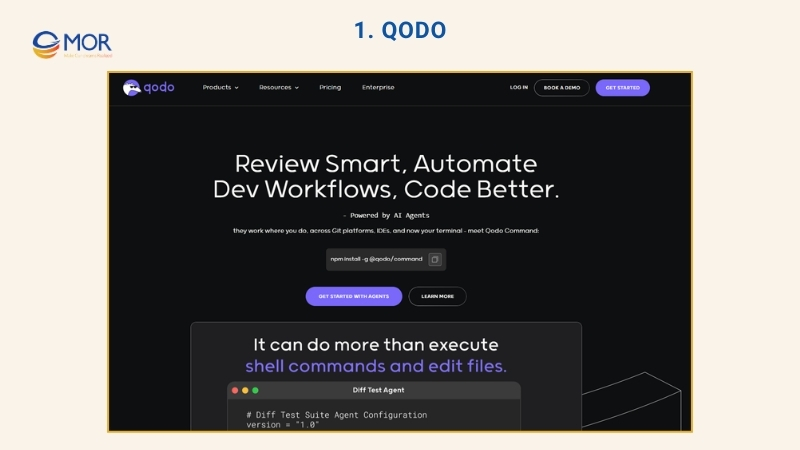
Pros of Qodo
- End-to-end coverage: Qodo’s agents handle everything. Gen creates code and unit tests, Cover improves test coverage, and Merge summarizes pull requests, detects risks, and automates reviews.
- Smarter suggestions: The AI code creator delivers relevant improvements, including error handling, docstrings, and clean code patterns, to maintain consistent quality.
- Code explanation: It breaks down complex snippets into plain language, making it easy for both junior and senior developers to understand logic and purpose.
- Automated testing: Qodo saves hours by generating precise and reusable test cases that fit large or intricate codebases.
- Behavior coverage: It checks for every possible execution path, ensuring comprehensive testing and reliability.
- Seamless collaboration: Git-based integration keeps reviews and communication in one place, making teamwork effortless.
- Cross-language and IDE support: Works smoothly with Python, TypeScript, and JavaScript, and supports top IDEs like VS Code, WebStorm, and IntelliJ IDEA.
- Efficient pull request reviews: The Qodo Merge extension provides AI-based summaries and suggestions, speeding up approval cycles.
Cons of Qodo
Some advanced options, such as static code analysis and compliance in Merge Pro, are part of the paid plans. This could be restrictive for small development teams or solo developers experimenting with code generator AI tools.
Our Experience with Qodo
When testing Qodo Gen and Merge in an open-source computer vision project, the AI code generator quickly became a reliable partner. Using Qodo Gen on the DiffMotionDetector class, it produced comprehensive Python test cases. One validated binary threshold behavior, while another handled cases where inputs were missing. The assistant’s chat helped polish the logic, document functions, and identify bugs. It also supported multiple model options, including OpenAI, Claude, Gemini, and Qodo’s own models.
Meanwhile, Qodo Merge proved powerful for PR management. Simple commands like /describe, /ask, /improve, and /review delivered detailed insights, from summarizing PRs and scanning for security flaws to spotting redundant tests. Running “@CodiumAI-Agent /review” even provided an effort score and focused recommendations for optimization.
Together, Qodo Gen and Qodo Merge create a cohesive development loop, writing, testing, and reviewing, all powered by intelligent automation.
Qodo Pricing
- Developer (Free): 250 credits for code creation, test generation, reviews, and documentation.
- Teams ($30 per user/month): 2,500 credits with enhanced PR descriptions, workflow automation compliance, and team-based learning tools.
- Enterprise (Custom): Unlimited credits, full platform access, priority support, and deployment flexibility (SaaS or on-prem).
Expert Take
The free plan is ideal for individuals experimenting with AI code generators, while Teams offers strong value for startups. Enterprise plans best suit companies needing secure, large-scale deployments and audit-ready environments. Qodo delivers a trustworthy blend of automation, precision, and collaboration, everything you’d expect from a next-gen code generation AI platform.
2. GitHub Copilot
GitHub Copilot is one of the most popular AI code generator tools in the world. Designed to autocomplete code intelligently, it has become a trusted companion for developers aiming to speed up development and reduce repetitive work. Built through a collaboration between GitHub, OpenAI, and Microsoft, Copilot uses a generative AI for coding model that understands developer intent and produces instant code suggestions in real time.
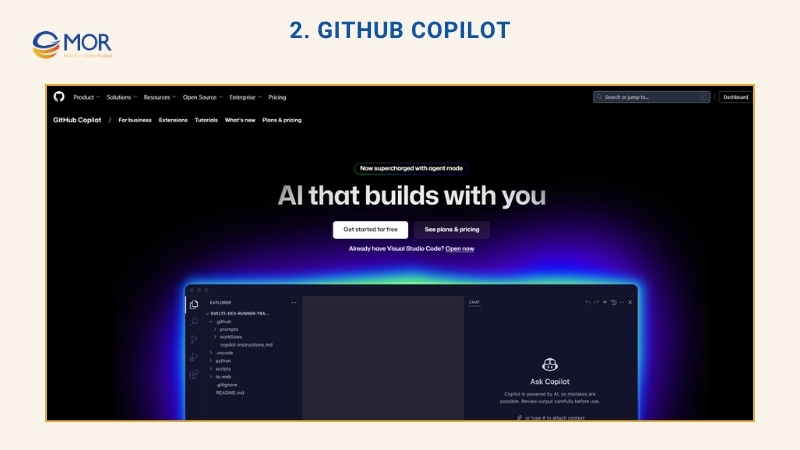
Pros of GitHub Copilot
- Smart code suggestions: The tool predicts and completes entire lines or functions based on comments or partial input, helping developers write code faster with fewer errors.
- In-editor chat: Its built-in chat assistant can answer questions, fix bugs, or explain logic without leaving the editor.
- Quick navigation: You can easily browse through several autocomplete options and pick the best match for your current task.
- Cross-platform compatibility: Copilot integrates smoothly with Visual Studio, VS Code, Neovim, and JetBrains. It supports major fastest programming languages including Python, TypeScript, Go, and JavaScript.
Cons of GitHub Copilot
Copilot sometimes reproduces similar code patterns from its training data, leading to potential duplication across projects. It may also produce inefficient or inaccurate code, especially in complex cases. Beginners might struggle to catch these issues. Additionally, it has limited automated test generation for large projects, which can make quality assurance harder. Some advanced collaboration features, such as team-based PR reviews and GitHub Codespaces integration, are only available under paid plans.
Our Experience with GitHub Copilot
In practice, using GitHub Copilot inside Visual Studio Code felt like having a live coding partner. When prompted with “create a Terraform config with a Google Cloud Storage bucket named ‘logs’ and versioning enabled,” the AI code generation system immediately produced a complete Terraform script.
The generated code included:
- Provider configuration for Google Cloud.
- A defined google_storage_bucket resource named logs.
- Versioning enabled within a separate block.
- Variables for project_id and region to make the file environment-independent.
After adding your project ID, the file can be applied directly using Terraform without further edits. The result was valid, readable, and production-ready.
GitHub Copilot Pricing
- Free: $0 per user/month, suitable for individuals and students.
- Team: $4 per user/month, adds collaboration and management tools.
- Enterprise: From $21 per user/month, designed for large organizations needing compliance and custom deployment.
Expert Take
GitHub Copilot remains one of the most accessible and reliable best AI for code generation today. The free plan is great for casual use, the Team plan fits growing developer teams, and the Enterprise version supports advanced governance. Whether you’re writing Python, JavaScript, or infrastructure scripts, Copilot offers a consistent boost to productivity and creativity in coding.
3. Tabnine
Tabnine earns its place among the top AI code generator tools thanks to its strong mix of intelligence, security, and customization. It enhances your workflow with context-aware code completions, refactoring support, real-time linting, and automatic documentation. Together, these features help developers write cleaner, more maintainable code with fewer mistakes.
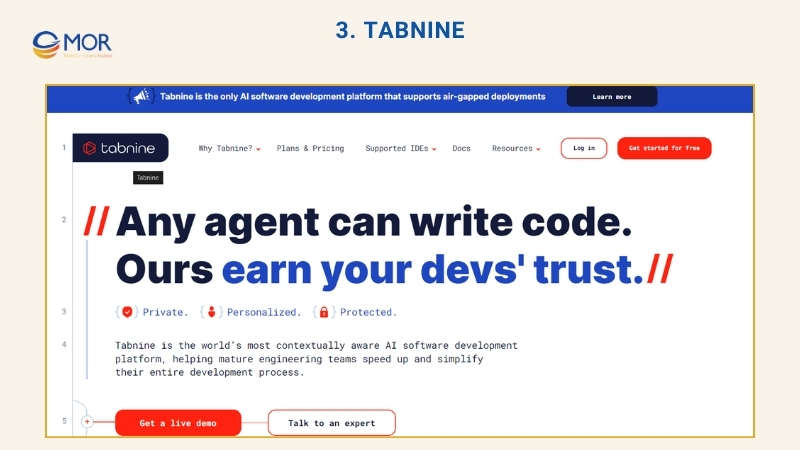
Pros of Tabnine
- Refactoring assistance: The tool provides smart suggestions for improving structure, readability, and efficiency, helping developers refactor code with confidence.
- Built-in linting: Its continuous linting system identifies syntax or logic issues instantly, suggesting fixes before they become bugs.
- Automatic documentation: One of the standout features is how it auto-generates docstrings and explanations, making team collaboration smoother and improving onboarding for new members.
- Contextual completions: Powered by deep learning and trained on open-source code, the code AI generator predicts what you’re about to type and offers relevant completions in real time.
- Enterprise security: The enterprise plan keeps all processing local, guaranteeing that proprietary code never leaves your system.
- Personalization: Tabnine can be tuned to fit your team’s style guide, preferred patterns, and language-specific conventions.
Cons of Tabnine
The free plan only provides basic autocompletion, with advanced ai automation suggester like AI chat and documentation reserved for paid users. Developers new to certain languages might also find its early suggestions less intuitive since it doesn’t rely on public repository scraping for predictions.
Our Experience with Tabnine
In day-to-day use, Tabnine feels like a silent coding partner that anticipates your next move. When working on a Python project involving MySQL database connections, we used its “document code” function to polish my initial implementation. The AI code generation assistant recommended wrapping the connection logic into a reusable function, adding docstrings, and improving error handling. These adjustments made the code easier to maintain and reuse across modules.
The tool also integrates well with Claude, Gemini, and other LLMs in editors like VS Code, adding conversational coding support for debugging and refactoring. The result is smoother, faster development without sacrificing accuracy or readability.
Tabnine Pricing
- Free: $0 per user/month: basic AI code generation and autocomplete.
- Dev: $9 per user/month: adds AI chat, contextual generation, test creation, and Jira integration.
- Enterprise: $39 per user/month: includes advanced security, on-prem deployment, and customizable rules.
Expert Take
Tabnine’s free tier is perfect for individual developers testing AI code generators, while the Dev plan fits professionals who code daily. The Enterprise plan, with on-premise deployment and compliance features, is ideal for organizations that value data privacy. Overall, Tabnine strikes a smart balance between automation and control, making it a reliable companion for modern software teams.
4. Bolt
Bolt is a browser-native AI code generator built on StackBlitz WebContainers. It lets you describe full-stack applications in plain English, then instantly generates, runs, and deploys them, all directly in your browser. No installation, local setup, or external tooling required. It’s a fast, intuitive way to turn ideas into working web apps within minutes.
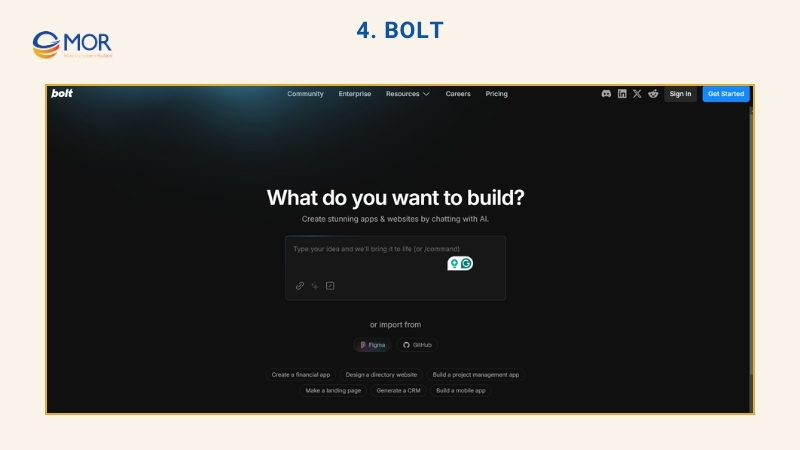
Pros of Bolt
- Runs fully in the browser: Bolt manages everything, installations, terminal commands, coding, and deployment, without touching your local environment.
- Prompt-to-app creation: The AI program generator interprets natural language prompts to scaffold complete frontends, backends, and project structures automatically.
- Built-in integrations: Supports Netlify for hosting, Supabase for backend services, Stripe for payments, and GitHub for collaboration.
- Perfect for prototyping: Great for building MVPs, testing product ideas, or teaching full-stack architecture in real time.
Cons of Bolt
- Locked editor environment: Works only inside the Bolt interface and doesn’t support IDEs like VS Code or JetBrains.
- Not production-ready: Geared toward small projects or demos rather than enterprise-scale development.
- Still in beta: Occasional bugs or misinterpreted prompt engineering techniques can appear, especially in complex multi-file projects.
Our Experience with Bolt
While testing Bolt, I used it to build a session-tracking web app called FocusFlow that logged work intervals, categorized tasks, and saved session history. The AI code generation engine created a complete React + TypeScript setup with folders, dependencies, and key components like TaskForm.tsx and Timer.tsx.
The generated TaskForm.tsx came prefilled with typed props, input fields, and simple validation logic. It saved me the repetitive effort of setting up React state management and form handling manually. That said, the quality of Bolt’s output depended on how clear and detailed the prompt was. Some parts, like UI flow and state handling, still needed manual tweaks to reach production quality.
Overall, Bolt proved fast and practical for prototyping and bootstrapping projects. It’s an excellent AI code generation tool for testing ideas quickly but still benefits from human review before deployment.
Bolt Pricing
- Free: $0: great for casual users and quick experiments.
- Pro: $25/month: higher token limits, added customization, and branding features.
- Teams: $30 per member/month: collaboration tools with admin controls.
- Enterprise: Custom pricing: designed for secure, large-scale integrations with dedicated support.
Expert Take
Bolt is ideal for developers or teams who want to spin up full-stack prototypes in minutes without leaving the browser. The free plan works well for testing, Pro unlocks consistent daily use, and Teams enables real-time collaboration. Enterprise customers benefit from governance and security options. While it’s not built for massive projects yet, Bolt is a solid choice for rapid experimentation and education in AI code generation.
5. Amazon Q Developer
Amazon Q Developer is a cloud-focused AI code generator designed for developers building on AWS. Available in both command-line and IDE versions (including VS Code), it helps you write, test, and secure code while aligning with AWS-native best practices. The tool supports intelligent automation for code editing, security scanning, and deployment, all while respecting your IAM roles and access controls.
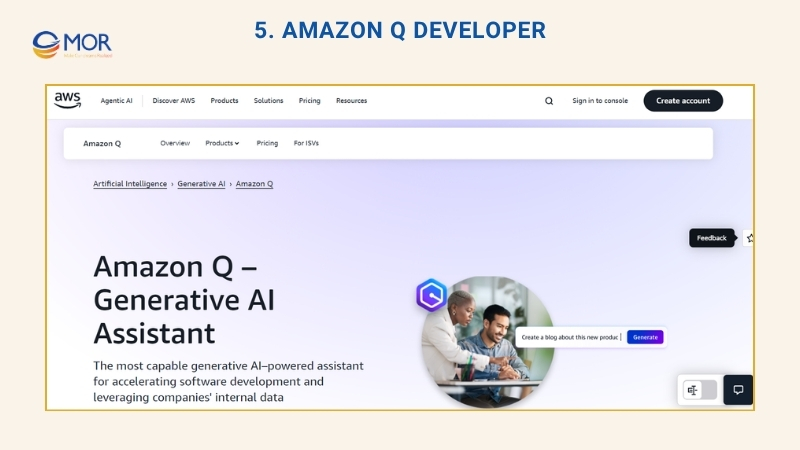
Pros of Amazon Q Developer
- IDE integration: Works seamlessly inside VS Code, offering inline chat, multi-file editing, and step-by-step execution of coding tasks.
- Agentic task automation: This AI code generation assistant can execute bash commands, create diffs, and communicate directly with AWS APIs to perform real tasks in your environment.
- Security-first design: All operations adhere to AWS Identity and Access Management (IAM) rules, ensuring full data ownership and compliance.
- Cross-platform context awareness: Its MCP collaboration mode allows the assistant to pull and process external data from connected systems during execution.
Cons of Amazon Q Developer
It performs best within AWS environments, so teams using other platforms may find its capabilities limited. Some developers have also noted that its responses are less polished when handling non-AWS-specific coding tasks.
Our Experience with Amazon Q Developer
We tested Amazon Q by asking it to create a GitHub webhook listener using FastAPI within Visual Studio Code. The AI code creator understood the request instantly and generated a secure, production-ready microservice. The resulting main.py file included a webhook endpoint /webhook/github with HMAC-SHA256 validation using the X-Hub-Signature-256 header and hmac.compare_digest() to prevent timing attacks.
It automatically added:
- A /health endpoint for monitoring
- A .env template for environment variables (e.g., GITHUB_WEBHOOK_SECRET, PORT)
- A requirements.txt file listing dependencies like fastapi and uvicorn
- A README file detailing setup steps, environment variables, and GitHub webhook configuration
The code generation AI completed everything without additional prompting. The workflow felt smooth and secure, especially since it integrated IAM validation for local execution and cloud deployment.
Amazon Q Developer Pricing
- Free Tier: $0 per user/month: basic AI development services and limited usage.
- Pro Tier: $19 per user/month: increased limits, deeper AWS integration, and organizational governance.
Expert Take
Amazon Q Developer is ideal for developers or teams who regularly build, test, and deploy on AWS. The free version is great for experimentation, while the Pro plan offers the scalability and compliance control needed for enterprise workflows. For anyone working heavily within AWS infrastructure, this AI code generator provides one of the most secure and integrated coding experiences available in 2025.
6. AskCodi
AskCodi earns its place among the best AI code generator tools for its balance between simplicity and practicality. It’s not just for generating snippets, it also assists with learning, debugging, and improving existing code. AskCodi integrates directly into leading IDEs like Visual Studio Code, PyCharm, and IntelliJ IDEA, making it an accessible and efficient tool for both beginners and experienced developers.

Pros of AskCodi
- Multi-language support: Generates and explains code in multiple programming languages, including Python, Java, TypeScript, Kotlin, Ruby, and Rust.
- Natural language Q&A: You can ask coding questions in plain English, and the AI code generation engine responds with concise, example-based explanations.
- Smart code suggestions: Analyzes your work and recommends improvements, helping fix bugs or enhance performance before deployment.
- Seamless IDE integration: Works natively in popular development environments, keeping you focused without switching tools.
Cons of AskCodi
Some users may find it tricky to phrase questions effectively, which can lead to less accurate answers. Its reliance on open-source data means certain niche scenarios may not be well-covered. Also, full access requires a paid subscription, which could be steep for casual users.
Our Experience with AskCodi
Using AskCodi for AI code generation felt like working alongside a helpful pair of extra eyes. We relied heavily on its code suggestion feature to review and refine functions across Python and TypeScript projects. It flagged unused variables, proposed cleaner logic, and even hinted at better machine learning algorithm.
One example involved optimizing a file parsing function, AskCodi suggested switching to generator-based iteration to save memory. That single fix improved performance significantly. Still, when we weren’t clear enough in our query, the output sometimes drifted off-topic. The takeaway? The more specific and detailed the prompt, the more valuable the response.
AskCodi Pricing
- Premium: $149.99 per year: includes core integrations and steady monthly credits.
- Ultimate: $349.99 per year: designed for teams or power users who need expanded credits, multiple code spaces, and wider model access.
Expert Take
AskCodi is one of the most practical AI code generation tools for developers who want to code faster while learning along the way. The Premium plan suits individuals seeking steady assistance in daily work, while Ultimate is ideal for teams needing deeper collaboration and flexibility. Whether you’re debugging, learning a new language, or improving project quality, AskCodi delivers solid value for its price.
7. Warp
Warp is a modern, Rust-based terminal built to enhance developer productivity through AI code generation and collaboration. It replaces the traditional terminal experience with a block-based interface where every command and output is treated as a structured “Block.” Warp also integrates an AI assistant for intelligent command suggestions and a built-in sharing system, Warp Drive, that lets teams save and reuse workflows.
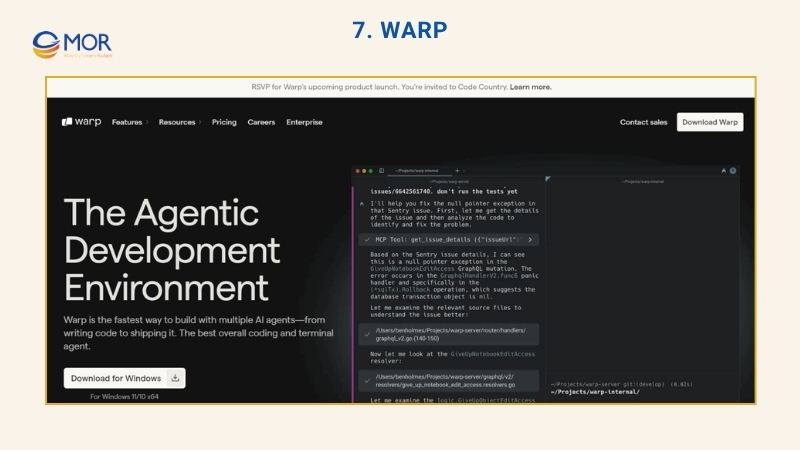
Pros of Warp
- AI-powered commands: The terminal interprets natural language prompts and converts them into accurate, context-aware shell commands.
- Block-based design: Commands and outputs are grouped into clean, editable blocks that can be copied, modified, or shared easily.
- Warp Drive workflows: Teams can save, customize, and share reusable terminal workflows, streamlining repetitive operations.
- Cross-platform compatibility: Built in Rust and optimized for macOS, Linux, and Windows, ensuring strong performance across environments.
Cons of Warp
The block-style layout takes some time to get used to, especially for those coming from classic terminals. Its Windows version still has minor inconsistencies, and free users face limits on AI requests. Warp also uses more system resources than lightweight options like Alacritty or iTerm.
Our Experience with Warp
We used Warp’s AI assistant to create a C++ concurrency demo directly from the terminal. The prompt we entered was: “Implement a thread-safe bounded queue in C++ using condition variables. It should support multiple producers and consumers without race conditions.”
Warp immediately parsed our intent, displayed a clear step-by-step task plan, and generated the files in our working directory. It produced a bounded_queue.h file featuring a templated BoundedQueue<T> implementation that used one std::mutex and two condition variables (cv_not_full_, cv_not_empty_) for safe multi-threaded coordination.
This hands-on session showed how powerful AI code generation tools can be even inside a terminal environment. Warp helped us move from idea to working code without switching between editors or documentation, proving itself a strong companion for developers who live in the command line.
Warp Pricing
- Free: Core terminal features, AI suggestions, and Warp Drive included.
- Pro: ~$15/month per user: adds higher AI request limits and priority support.
- Business: ~$55/month per user: includes admin controls, collaboration management, and zero-data retention.
Expert Take
The Free plan is great for individuals exploring Warp’s AI-powered features. Pro suits professionals and small teams who need faster assistance and more AI capacity. Business is built for enterprises seeking governance, compliance, and secure collaboration. Warp redefines the terminal experience, merging productivity and AI code creation into a unified, intuitive workspace.
8. Replit
Replit is an interactive, cloud-based development platform that combines real-time collaboration with AI code generation. It’s built for developers who want to write, test, and deploy code in one place while learning from intelligent in-line assistance. We included Replit in this list for its strong blend of coding support and educational features that make it suitable for both beginners and professionals.
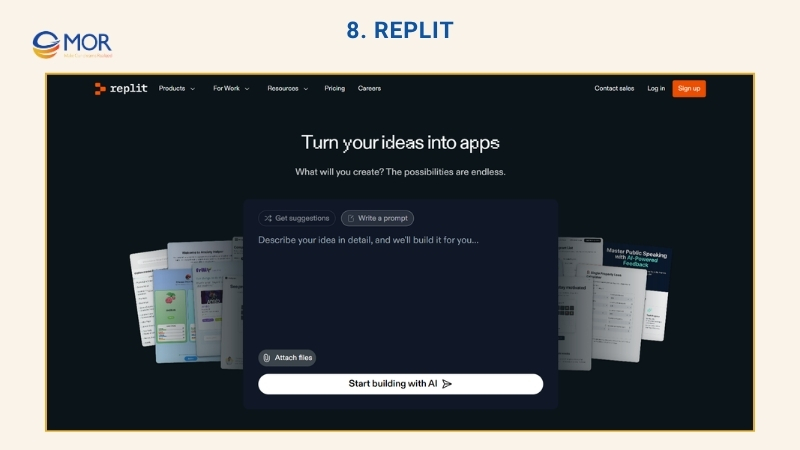
Pros of Replit
- Smart in-line suggestions: The AI assistant provides real-time code completions that speed up development and help maintain consistency.
- Code explanations and comments: It can interpret snippets and add meaningful documentation or inline comments to make code easier to understand.
- Error detection and fixes: The AI code generator identifies bugs or inefficiencies and suggests precise corrections, improving code accuracy.
- Interactive learning setup: Its built-in environment encourages hands-on learning while coding, making it ideal for developers looking to sharpen skills while building.
Cons of Replit
Replit works best with popular languages but may struggle with niche ones. Since it’s an online tool, a reliable internet connection is essential. Offline access and performance may be limited in some cases.
Our Experience with Replit
We used Replit’s AI code generation tool to create a chat interface using React and Tailwind. The goal was to build a simple AI assistant UI featuring modular components and a theme toggle for light and dark modes.
Our prompt was:
“Create a simple React + Tailwind UI for an AI assistant with a centered chat window, scrollable messages, a text input box with a Send button, and mocked assistant responses. Keep components modular and add a theme toggle.”
Replit’s AI assistant quickly produced a project plan, set up the folder structure, and generated modular components such as ChatWindow, Message, and InputBar.
The resulting app included:
- A centered chat window with a fixed header labeled “AI Assistant.”
- Scrollable message history with user messages aligned to the right and assistant replies on the left.
- A functional input bar with a Send button.
- Mocked assistant responses appearing after short delays to simulate real-time chat.
- A light/dark theme toggle built using Tailwind classes and saved via state persistence.
Replit’s live preview updated instantly as we refined the code. The output was modular, clean, and ready for future API integration, demonstrating how far AI code generation tools have come in accelerating front-end workflows.
Replit Pricing
- Starter: Free: includes 10 development apps, temporary links, and a Replit Agent trial.
- Replit Core: $20/month (billed annually): for individuals building and deploying advanced apps.
- Teams: $35/user/month (billed annually): adds collaboration tools and private deployments.
- Enterprise: Custom pricing: tailored for organizations needing full security, compliance, and dedicated support.
Expert Take
The Free plan is great for experimenting and learning in shared projects. Replit Core suits solo developers working on production-ready apps, while Teams offers strong collaboration for small groups. Enterprise is best for larger companies needing governance and control. With its blend of AI code generation and real-time collaboration, Replit continues to be one of the most versatile platforms for learning, building, and scaling applications in the browser.
9. Qwen3-Coder (Unsloth)
Qwen3-Coder (Unsloth) is Alibaba’s open-source, agentic AI code generator that rivals the largest commercial models. With up to 480B parameters and massive context windows, it enables autonomous coding workflows while giving developers complete offline control. Deployed through Unsloth, it supports efficient local inference, making it one of the most powerful open models for secure or air-gapped environments.
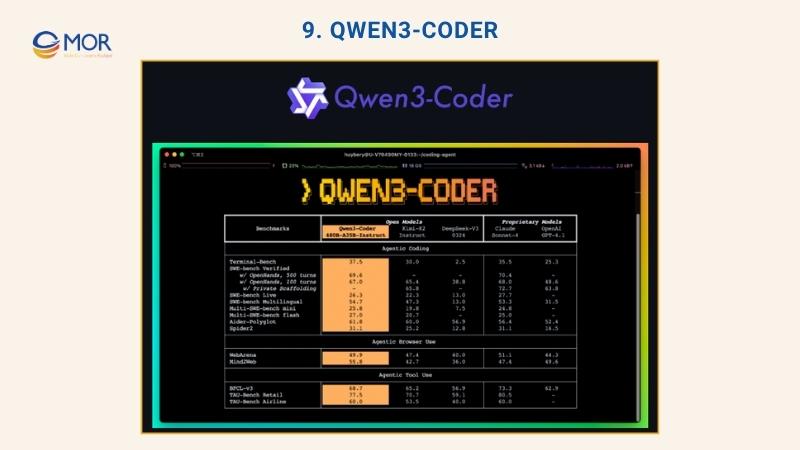
Pros of Qwen3-Coder (Unsloth)
- Agentic coding workflow: The model reads, edits, tests, and fixes code automatically through natural language or scripted prompts, replacing multiple tools with a single intelligent enterprise search engine.
- Massive context length: With 256K–1M token support, the AI code generation system can analyze full repositories, long traces, or deeply nested logic without breaking context.
- Optimized through Unsloth: Uses 2–8-bit dynamic quantization and GGUF formats to run efficiently on standard GPUs and CPUs, reducing memory load while maintaining accuracy.
- Local-first design: Operates entirely offline using backends like llama.cpp or Ollama, with zero API calls or telemetry, ideal for secure or regulated organizations.
Cons of Qwen3-Coder (Unsloth)
The 480B model demands around 150GB of unified memory, which limits full use to high-end GPUs. Developers without A100-class hardware can instead run smaller 32B or 110B versions. Setup can be technical, requiring manual tuning and quantization configuration. It also lacks native IDE integration, meaning you’ll need wrappers like Continue.dev, Aider, or Cursor for editor compatibility.
Our Experience with Qwen3-Coder
We used Qwen3-Coder through Unsloth to build a Bash automation script for folder backups. The prompt was:
“Create a Bash script that backs up a given folder into a timestamped .zip file, defaulting to the current directory, with optional destination paths and proper error handling.”
The AI code generation tool parsed the request, checked the environment, and produced a working script instantly. The resulting backup_folder.sh included:
- Parameterized inputs: Accepted [source_folder] and [destination_folder] as arguments with defaults for current paths.
- Robust error handling: Verified folder existence and provided clear failure messages.
- Timestamped backups: Used date +"%Y-%m-%d_%H-%M-%S" to create uniquely named archives.
- Portable output: Relied on zip for compatibility across Linux and macOS systems.
The workflow felt smooth, fast, and fully local, no cloud dependencies or API delays.
Qwen3-Coder Pricing
- Free and Open-Source: Available under the Apache 2.0 license, including all model weights, Unsloth deployment tools, and quantization configurations.
Expert Take
Qwen3-Coder (Unsloth) is one of the most flexible open AI code generation tools available in 2025. It’s cost-free, secure, and highly customizable, ideal for developers or enterprises who prefer local, private AI workflows. While setup requires some technical know-how, the control and performance it delivers make it an outstanding option for building intelligent coding assistants without vendor lock-in.
10. OpenAI Codex
OpenAI Codex is a groundbreaking AI code generator that converts plain English instructions into functional code across dozens of programming languages. It was one of the first models to popularize natural language programming, helping developers bridge the gap between human intent and executable logic. Codex powers several coding tools, including GitHub Copilot, and remains a benchmark in AI development services.
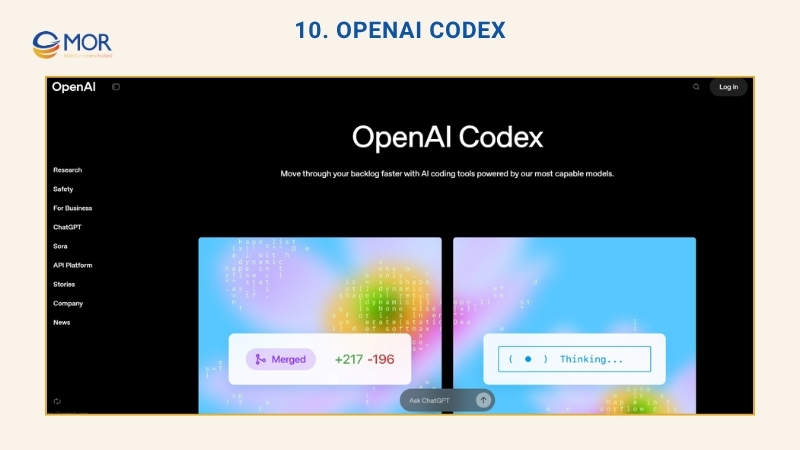
Pros of OpenAI Codex
- Fast and easy setup: Developers can start using Codex quickly thanks to its straightforward setup and API-based integration.
- Advanced code completion: The AI code generation system provides accurate, context-aware suggestions that accelerate development and minimize repetitive typing.
- Natural language prompting: Developers can describe what they want in simple English, and Codex instantly generates relevant code snippets or full functions.
- Broad language coverage: Supports Python, JavaScript, Go, Ruby, TypeScript, Swift, PHP, Shell, and many more, making it versatile for most software projects.
- Extensive training data: Trained on natural language and billions of lines of public source code, including GitHub repositories, allowing it to understand diverse coding patterns.
- Deep contextual memory: Offers a 14KB memory capacity for Python, giving it a longer contextual range than earlier GPT-3 models, useful for working with complex scripts.
- Multi-purpose flexibility: Suitable for code completion, translation between languages, refactoring, and even generating test cases or documentation.
Cons of OpenAI Codex
The pay-as-you-go pricing can become expensive for high-volume users. It also requires some configuration to achieve the best results, and while its suggestions are often strong, they aren’t always optimal or efficient. Developers still need to review outputs carefully.
Our Experience with OpenAI Codex
When we used OpenAI Codex for AI code generation, it quickly became a valuable part of our workflow. The natural language prompting feature stood out the most. We could simply type instructions like “write a Python script that reads a CSV file and prints the top 10 rows sorted by date”, and Codex produced clean, functional code instantly.
The completions were context-aware, adjusting based on variable names, project structure, and recent inputs. It also handled code explanations and refactoring requests effectively. However, while it boosted productivity, cost and occasional inefficiencies made it better suited for guided use rather than complete automation.
OpenAI Codex Pricing
- Token-based model: Developers pay per 1,000 tokens (roughly 750 words) or per million tokens for higher-volume usage.
- Rates vary by model: Costs depend on the chosen Codex variant and usage volume.
- Starter tier: Free access for basic experimentation, with scalable pricing for production-level projects.
Expert Take
OpenAI Codex remains a leading choice for developers exploring AI code generation tools with strong natural language understanding. The token-based pricing offers flexibility, ideal for light or experimental use, while enterprises can estimate predictable costs at larger scales. Though setup and optimization take some work, Codex continues to shape how developers write and think about code in 2025.
11. Sourcegraph Cody
Sourcegraph Cody is a context-aware AI code generator that integrates directly with Sourcegraph’s powerful code search engine. What makes it stand out is its deep understanding of your repositories, documentation, and comments, allowing it to provide precise, context-based suggestions. It’s designed for developers who want both automation and insight across massive, evolving codebases.
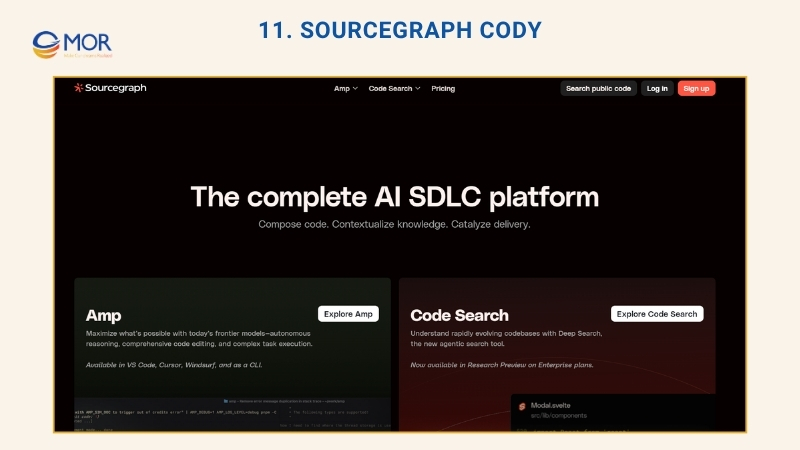
Pros of Sourcegraph Cody
- Fast code generation: Generates complete functions or quick snippets in any supported language on demand.
- Deep code insights: Explains individual segments or full repositories, helping teams grasp unfamiliar or legacy code quickly.
- Instant test creation: The AI code generation tool can produce unit tests within seconds, saving developers hours during the testing phase.
- Code smell detection: Identifies bad practices, performance bottlenecks, or potential bugs and suggests optimized alternatives.
- Custom prompt support: Developers can define prompts that match their coding style or team workflow, improving accuracy over time.
- Intelligent autocompletion: Cody predicts lines or full functions contextually, cutting down on syntax errors and improving efficiency.
- Contextual awareness: Understands the broader codebase structure, offering relevant edits, documentation, and explanations.
- Flexible model support: Works with multiple large language models like Claude 3.5, GPT-4o, Gemini 1.5, and Mixtral-8x7B, with optional support for private LLMs through Amazon Bedrock or Azure OpenAI.
Cons of Sourcegraph Cody
Cody’s language coverage is still expanding, so niche frameworks or languages may not be fully supported. Its subscription plans can also be pricey for small development teams or startups.
Our Experience with Sourcegraph Cody
We used the Sourcegraph Cody extension in VS Code to analyze and review sections of a TypeScript project. The setup was seamless, and results appeared with a single click. Cody identified multiple “code smells” in seconds, suggesting improvements like adding input validation, optimizing data structures, and introducing type hints. Each recommendation came with short explanations and code samples showing the impact of each change.
Beyond analysis, Cody’s ability to link search results with context-aware AI suggestions made debugging and refactoring much faster. The tool felt especially useful for large repositories with intertwined dependencies, where manual reviews would have taken hours.
Sourcegraph Cody Pricing
- Enterprise Starter: $19 per user/month: supports up to 50 developers with private GitHub-based code search.
- Enterprise Search: $49 per user/month: adds advanced search, insights, monitoring, and enterprise-grade security.
Expert Take
Cody is one of the most capable AI writing code for large or complex repositories. The Starter plan fits smaller teams that want affordable access to AI-powered search and coding assistance. Enterprise Search, on the other hand, is ideal for organizations handling compliance, monitoring, and security at scale. With multi-LLM compatibility and deep context integration, Sourcegraph Cody stands out as a true enterprise-ready coding assistant.
12. DeepCode AI
DeepCode AI, developed by Snyk, stands out as a security-focused AI code generator that blends generative and symbolic AI to detect and fix vulnerabilities. Unlike traditional tools that depend solely on pattern recognition, DeepCode analyzes logic, intent, and risk exposure in real time. Its hybrid AI architecture was trained on Snyk’s extensive security database, making it a powerful companion for developers who prioritize safe and reliable code.
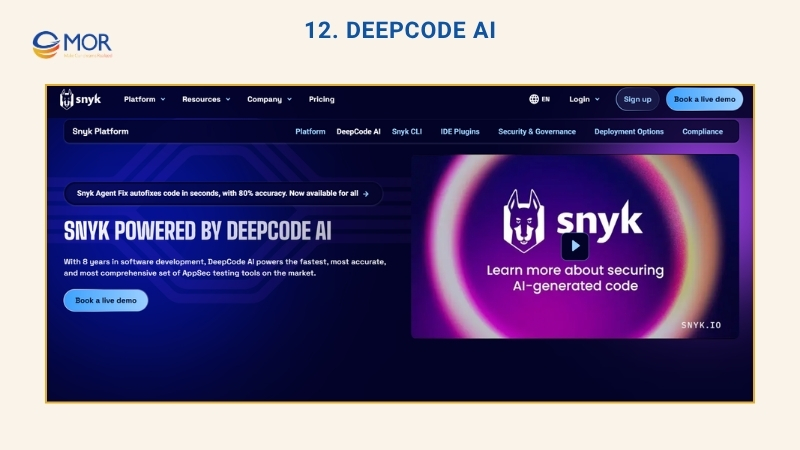
Pros of DeepCode AI
- Hybrid AI approach: Combines symbolic reasoning with generative modeling to deliver accurate, explainable, and low-hallucination results during AI code generation.
- Inline security fixes: Automatically suggests and validates quick fixes directly in your editor, with an average accuracy rate of around 80%.
- Custom rule creation: Allows developers to write and test their own security rules using DeepCode’s logic system, supported by smart autocomplete for faster setup.
- CodeReduce technology: Streamlines the analysis process by minimizing the code volume sent to the model, improving speed, reliability, and precision.
Cons of DeepCode AI
Its language support is somewhat limited, as Snyk prioritizes mainstream stacks like Python, Java, and JavaScript. Additionally, the advanced team plan can be costly for smaller developers or individual contributors.
Our Experience with DeepCode AI
We integrated DeepCode AI into our workflow via GitHub and Visual Studio Code to scan for security flaws in a Python project. Within seconds, the system flagged multiple issues, unused imports, unsafe input handling, and dependency risks. What impressed us was how the AI didn’t just highlight vulnerabilities; it proposed fixes, verified them automatically, and explained the reasoning behind each change.
The continuous monitoring feature also stood out. It kept scanning our repository in the background, catching potential regressions whenever new commits were pushed. The only drawback we noticed was limited support for niche languages, but for core frameworks, the results were consistent and precise.
DeepCode AI Pricing
- Open Source: Free: covers public repositories.
- Personal: $5.99/user/month: for private repositories (single user).
- Enterprise: Custom pricing: includes on-premise hosting, governance tools, and security compliance features.
Expert Take
DeepCode AI is one of the most practical AI code generation tools for developers who care about secure coding. The free plan is ideal for open-source contributors, while the Personal plan offers affordable protection for individual projects. Enterprises gain the most value from its private deployment and policy enforcement capabilities. By merging generative AI with symbolic logic, DeepCode bridges the gap between fast development and strong cybersecurity, a combination that makes it indispensable in modern software pipelines.
13. Figstack
Figstack is an all-in-one AI code generator and assistant that simplifies code understanding, translation, and optimization. It tackles common development challenges by explaining logic in plain language, translating between programming languages, and analyzing performance efficiency, all from a single interface. It’s especially useful for developers who work across multiple tech stacks or need quick, accurate insights during daily development.
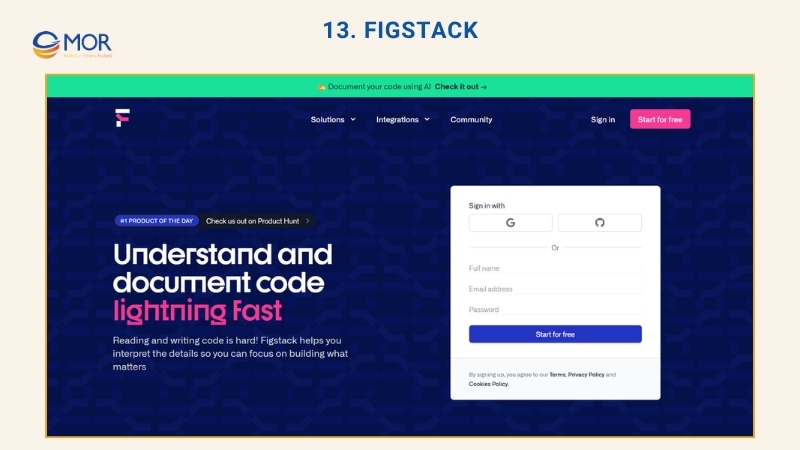
Pros of Figstack
- Natural language code explanation: Converts complex logic into clear, easy-to-read descriptions, helping developers quickly grasp unfamiliar code.
- Cross-language translation: Instantly translates snippets between programming languages, making it easier to migrate projects or learn new frameworks.
- Automated documentation: Generates detailed docstrings for every function, including parameters and return values, ensuring maintainable and well-documented code.
- Time complexity analysis: Evaluates algorithm efficiency using Big O notation, helping developers pinpoint performance issues and optimize critical sections.
Cons of Figstack
The free plan includes only limited credits, which can run out quickly on large projects. A stable internet connection is required to use the tool, and many advanced functions are available only in paid plans. While the platform is intuitive, new users may need a short adjustment period to fully utilize its integrations and automation features.
Our Experience with Figstack
We used Figstack’s AI code generation and translation capabilities to convert a Python stack function into Go. The process was fast and accurate, the translated code maintained logic, structure, and readability across both versions. The side-by-side comparison view also helped verify syntax and data handling consistency.
Beyond translation, we found its explanation mode invaluable for team onboarding. Junior developers could paste in unfamiliar code and instantly receive natural-language breakdowns of what each function did, including edge cases and expected outputs. The time complexity analysis further helped us identify potential performance bottlenecks in loops and recursive calls.
Figstack Pricing
- Free: $0: basic explanations and translations with limited credits.
- Starter: $9/month: expanded credits, GitHub integration, and file-level analysis.
- Unlimited: Custom pricing: for teams or professionals with high-volume use.
Expert Take
Figstack is one of the most well-rounded AI code generation tools for developers juggling multiple programming languages. The free plan works well for quick code reviews or explanations, while the Starter plan supports daily professional use. Unlimited access is ideal for teams that rely on AI-powered translation, documentation, and analysis to streamline multi-language development workflow.
14. IntelliCode
Microsoft IntelliCode is an AI code generator built directly into Visual Studio and VS Code, designed to deliver real-time, intelligent code completions. What sets it apart is how it learns from thousands of top open-source GitHub repositories, allowing it to predict your next line of code with impressive accuracy. It brings context-aware assistance right into the IDE, helping developers write cleaner, faster, and more consistent code.
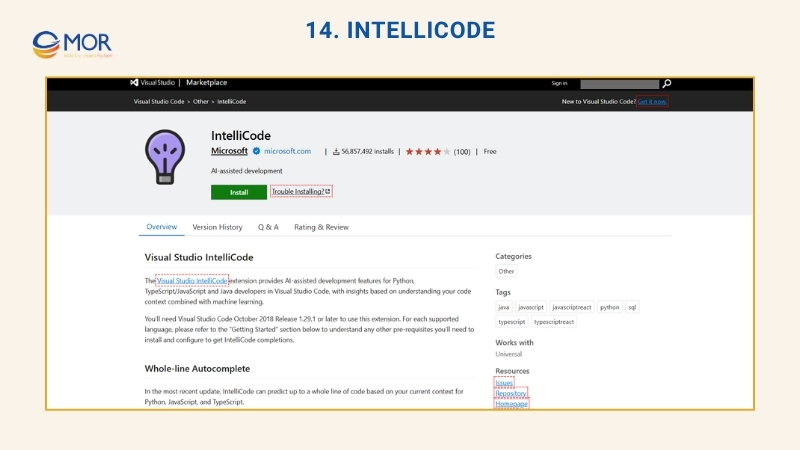
Pros of IntelliCode
- Whole-line autocompletion: The AI code generation engine predicts and completes entire lines of code based on context, improving speed and reducing manual typing.
- Local privacy: Runs entirely on the developer’s device, keeping all source code private while still providing intelligent, context-driven recommendations.
- Smart IntelliSense: Learns from GitHub projects and prioritizes the most relevant methods, variables, and parameters as you type.
- Pattern-based quick actions: Detects common edits or repetitive patterns, such as adding constructor parameters, and suggests one-click fixes.
- Consistent refactoring: Identifies repetitive code changes and applies them automatically across files for consistency.
Cons of IntelliCode
The tool’s suggestions may be less effective in large, multi-language repositories where context varies widely. It can also cause slight performance slowdowns when handling massive projects in VS Code or Visual Studio.
Our Experience with IntelliCode
We tested IntelliCode in VS Code while setting up MySQL database connections in a Python project. When hovering over mysql.connect(), IntelliCode surfaced real-world usage patterns drawn from open GitHub repositories. It even provided snippets showing best practices for connection setup, parameter handling, and error management.
By selecting these examples, we could instantly view, copy, and adapt proven code patterns without searching through documentation. The AI code generation tool effectively saved us time and improved accuracy by bringing practical, example-based learning right into our editor.
IntelliCode Pricing
- Free: Included with Visual Studio and VS Code: no additional cost.
Expert Take
IntelliCode is one of the most accessible AI code generation tools for developers already using Microsoft’s ecosystem. Its integration with VS Code and Visual Studio makes setup effortless, while its privacy-first local processing ensures security. For developers who want real-world, contextually relevant code suggestions without leaving their IDE, IntelliCode is a must-have companion.
15. CodeGeeX
CodeGeeX is a multilingual AI code generator designed to make everyday coding faster and more intuitive. It delivers practical features like code generation, translation, and explanation, all built into a clean, developer-friendly interface. What makes it stand out is its ability to simplify small coding tasks while helping teams understand and document their code without switching tools or browsing the web.
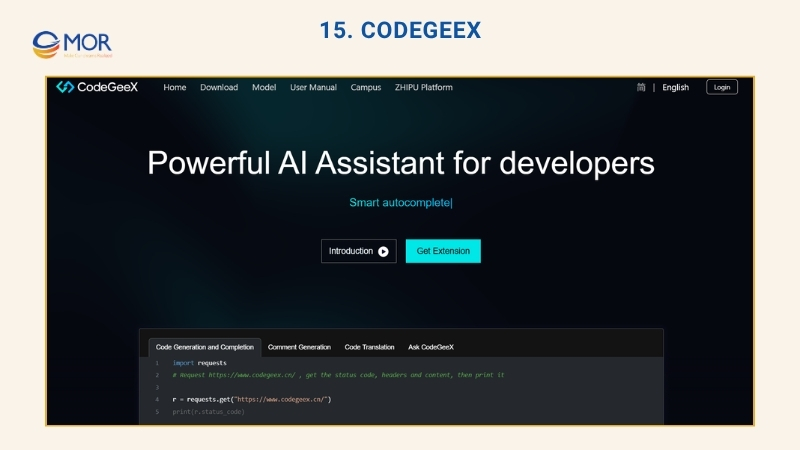
Pros of CodeGeeX
- Accurate code generation and completion: The AI code generation engine turns plain text into clean, functional code, completing single lines or entire blocks to speed up development.
- Code translation: Converts snippets between languages such as Python, JavaScript, Go, and C++, making it easier to work across tech stacks.
- Automatic comment creation: Generates line-level explanations and docstrings automatically, improving readability and documentation quality.
- Built-in AI chatbot: Answers quick technical questions directly in your IDE, keeping developers focused and productive.
- Extensive IDE and language support: Works with popular tools like VS Code and JetBrains IDEs and supports over 15 programming languages.
Cons of CodeGeeX
Some advanced features and higher usage tiers are locked behind paid plans, which might limit users who prefer free tools or work on smaller budgets.
Our Experience with CodeGeeX
We tested CodeGeeX in a Python project to evaluate its explanation feature. After writing a small time-printing function, we asked the assistant to describe the logic. Within seconds, CodeGeeX provided a clear explanation of how the function worked, including its purpose, flow, and timing logic.
This kind of inline clarification proved especially valuable when reviewing or documenting legacy scripts. The AI code generation tool also handled language translation seamlessly, converting small Python examples into Go syntax with accurate function definitions and formatting. It’s a reliable companion for teams juggling multiple languages or needing quick AI-powered insights.
CodeGeeX Pricing
- Free: Access to core multilingual code generation features in 15+ languages.
- Paid Plans: From $9/month: unlocks advanced features, expanded limits, and premium access.
Expert Take
CodeGeeX is one of the most versatile yet lightweight AI code generators available today. The free plan covers most daily needs, while paid tiers are well-suited for professional developers managing multilingual projects. With its blend of simplicity, speed, and contextual accuracy, CodeGeeX is an ideal assistant for anyone looking to enhance productivity and understanding within their coding workflow.
16. Cline
Cline is a local-first AI code generator and coding agent for VS Code that focuses on structured task execution rather than autocomplete. Unlike traditional AI assistants that generate code automatically, Cline works through a “plan and act” workflow, you give it a goal, it outlines the steps, and executes only after your approval. It’s built for developers who want automation with full transparency and control over their projects.
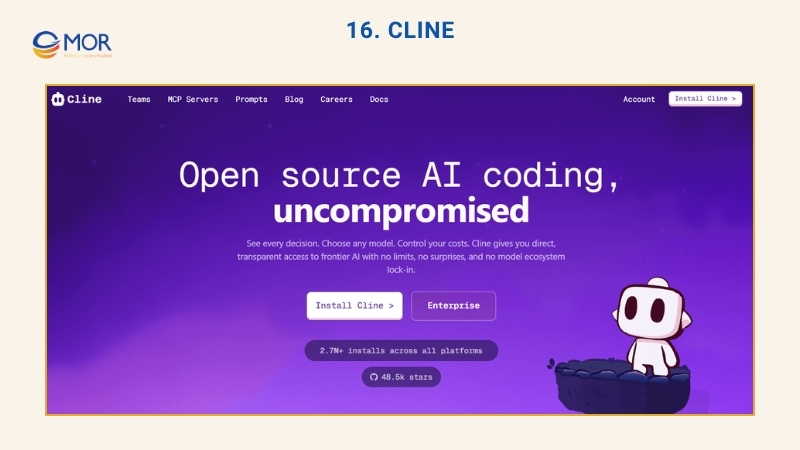
Pros of Cline
- Plan-and-Act workflow: Every action is reviewed and confirmed before execution, ensuring safety and precision.
- File and terminal control: Reads and modifies files, runs shell commands, and launches test sessions directly within VS Code.
- Snapshot checkpoints: Saves workspace states automatically for easy rollback or change tracking.
- Flexible model integration: Compatible with multiple large language models like Claude, DeepSeek, Gemini, and local models through Ollama.
- Local-first and open-source: Runs entirely on your system with no telemetry, making it ideal for privacy-conscious teams and regulated environments.
Cons of Cline
Cline doesn’t provide inline autocompletion and requires explicit instructions for each task, making it less suitable as a real-time copilot. It also needs manual configuration with API keys or local models and can slow down when handling very large or deeply nested repositories.
Our Experience with Cline
We used Cline in VS Code to build a distributed event-driven system in Go for a microservices-based architecture. The prompt was:
“Implement a distributed event-driven architecture in Go with an event bus, error handling utilities, and service-specific event handlers.”
Cline broke the task into a clear plan before executing anything. It proposed to:
- Create error utilities inside microservices/common/utils/errors.go.
- Build an eventbus.go to manage event publishing and subscriptions.
- Generate service-level event handlers.
- Update each microservice to integrate with the new event-driven design.
Before applying changes, it displayed file modifications and code diffs for approval. The generated event bus leveraged sync.RWMutex for concurrent safety and sync.WaitGroup to coordinate handler execution. We could approve or reject each edit, watch test sessions run, and roll back to previous states using snapshot checkpoints.
This AI code generation process provided the perfect balance of automation and oversight, Cline handled repetitive setup tasks while we retained full ownership of architectural decisions.
Cline Pricing
- Open Source: Free: ideal for individuals and small teams; open and auditable.
- Cline Teams: $30/user/month or $300/user/year: adds admin tools, security features, and dedicated support.
Expert Take
Cline stands out among AI code generation tools for developers who value structure, auditability, and local execution. The free open-source version is perfect for solo developers experimenting with task-based workflows, while the Teams plan suits organizations needing managed access and collaboration. For projects requiring high transparency and strict data privacy, Cline delivers one of the most secure and developer-friendly automation experiences available today.
17. Augment Code
Augment Code is an intelligent, enterprise-grade AI code generator built to understand your entire project context. It indexes your full workspace, code, documentation, dependencies, and configurations, to deliver highly relevant code completions, natural-language instructions, and task-based automation. The platform integrates seamlessly with VS Code, JetBrains, and Vim/Neovim, letting developers chat with the AI, execute commands, or apply multi-file edits directly within their editor.

Pros of Augment Code
- Deep context indexing: Scans your complete workspace to provide context-aware suggestions that match your project’s architecture and dependencies.
- Robust editor integrations: Offers chat, inline guidance, and “Next Edit” workflows across major IDEs for a smooth development experience.
- Agent-based execution: Plans tasks, runs terminal commands, edits files, and reviews changes while maintaining rollback checkpoints.
- Memory and coding guidelines: Retains team rules, naming conventions, and style preferences for consistent AI code generation results.
- Enterprise-grade compliance: Certified under ISO/IEC 42001 and SOC 2 Type II with options for customer-managed encryption keys and no training on proprietary code.
Cons of Augment Code
Setup takes some effort, as developers must index the project and define workspace rules before using advanced agents effectively. The more powerful features, like enterprise security and full compliance, are reserved for paid tiers. Some users also report occasional missteps, such as duplicated tests, when prompts lack precision.
Our Experience with Augment Code
We used Augment Code to enhance a TypeScript-based RingBuffer by adding a method for item removal. The request was simple: “Add a function to remove a specific item from the RingBuffer.” Augment immediately analyzed the buffer structure and generated a removeItem() method that:
- Iterated through the buffer using modular arithmetic for wraparound behavior.
- Detected and removed the target item, returning true if found or false otherwise.
- Updated the associated test file (ring-buffer.test.ts) with new test cases covering both success and failure scenarios.
The inline previews allowed us to review every change before applying it, while context indexing ensured all edits aligned with the existing Jest framework setup. With AI code generation this precise, we were able to evolve the codebase quickly without sacrificing control or accuracy.
Augment Code Pricing
- Community: Free: includes up to 10 user messages with access to core tools and the Context Engine.
- Developer: $50/month: expands to 600 messages, adds team management (up to 100 users), and advanced compliance.
- Enterprise: Custom pricing: tailored for organizations needing full security, scalability, and dedicated support.
Expert Take
Augment Code bridges the gap between traditional coding assistants and autonomous development agents. The Community plan is ideal for individual experimentation, while the Developer plan fits small teams ready for production-scale projects. Enterprises benefit from its compliance and governance capabilities. With context-driven intelligence and human-in-the-loop transparency, Augment Code redefines what professional AI code generation tools can achieve in modern software development.
18. Gemini CLI
Gemini CLI is Google’s open-source AI code generator and terminal assistant that brings Gemini’s intelligence directly into your command-line environment. Operating in a ReAct-style loop, it interprets user intent, reasons about next steps, and executes commands using built-in tools. While primarily designed for coding tasks, it also supports documentation, file management, and multimedia generation through integrations like Imagen and the Model Context Protocol (MCP).
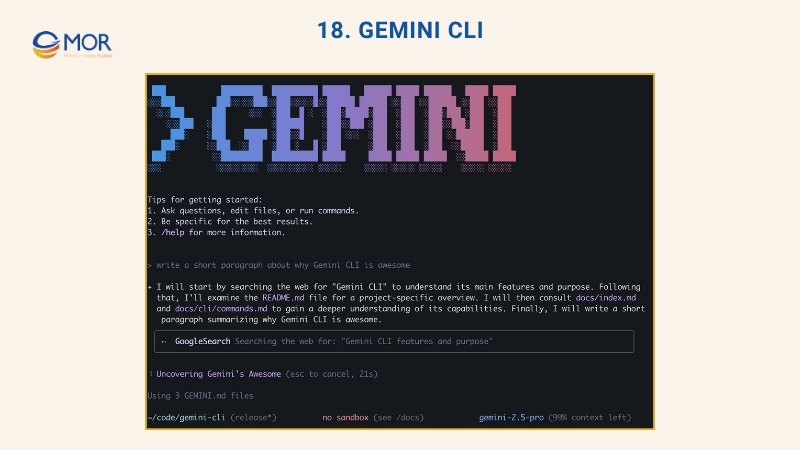
Pros of Gemini CLI
- Expansive context window: Powered by Gemini 2.5 Pro, it handles up to 1 million tokens, ideal for analyzing large codebases or reasoning across multiple files.
- Generous free quota: Offers 60 requests per minute and up to 1,000 per day, making it one of the most developer-friendly free tiers available.
- Rich built-in tools: Comes equipped with native grep, shell execution, file read/write access, Google Search grounding, and full MCP integration.
- Fully open-source: Distributed under the Apache 2.0 license, allowing inspection, modification, and self-hosting for complete transparency.
Cons of Gemini CLI
It’s still in public preview, so some APIs and integrations are evolving. Deep IDE integration remains limited, with most functionality living inside the terminal. Some users have also reported occasional slow responses or mismatched context during multi-file edits.
Our Experience with Gemini CLI
We used Gemini CLI to analyze the src/routes/transactions.js file in a Node.js Express project. The AI code generation tool quickly summarized the file’s logic and identified key issues in seconds. The route handled a POST /transactions request that required amount and cardNumber in the body, but Gemini detected three major security concerns:
- Unused fs module: Flagged as unnecessary, possibly indicating dead code or a potential attack surface.
- Hardcoded internalToken: Pointed out as a critical security flaw, recommending migration to environment variables in .env.
- Use of eval(): Warned that it could lead to remote code execution vulnerabilities, with clear explanations and remediation guidance.
What stood out was Gemini CLI’s ability to go beyond surface-level analysis. It explained why each issue mattered and how to fix it, effectively transforming static code review into an interactive debugging and security session. Its automatic parsing and contextual understanding made it a strong asset for improving Node.js API safety and maintainability.
Gemini CLI Pricing
- Standard: $22.80/user/month (monthly) or $19/user/month (annual).
- Enterprise: $54/user/month (monthly) or $45/user/month (annual).
Expert Take
Gemini CLI is one of the most capable AI code generation tools for developers who prefer terminal-driven workflows. The Standard plan is ideal for individuals or small teams building on Google Cloud or working with large projects. The Enterprise plan adds scalability, integrations, and advanced security options suited for bigger organizations. With open-source flexibility, broad context handling, and precise analysis, Gemini CLI sets a new standard for intelligent command-line development.
19. Lovable
Lovable is a browser-native AI code generator and app builder that turns plain-English project descriptions into fully functional full-stack applications. It automates everything, from frontend design and backend logic to database setup and deployment, without the need for a local IDE or manual infrastructure configuration.
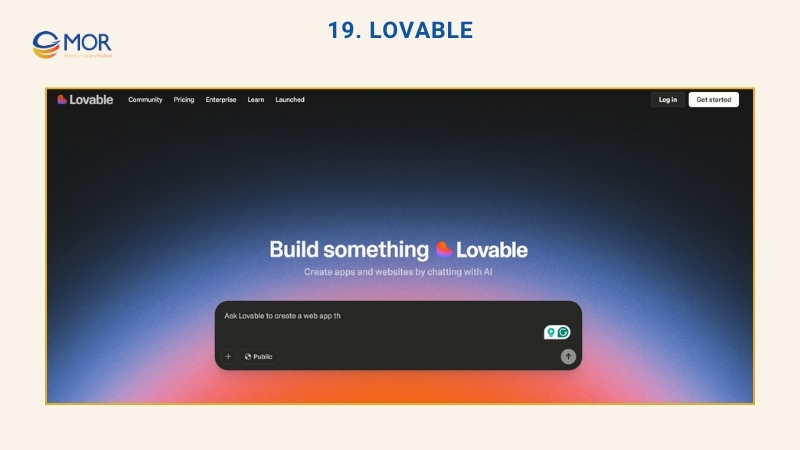
Pros of Lovable
- Prompt-to-app workflow: Simply type a natural request like “Build a blog with login and comments,” and Lovable scaffolds a React + Tailwind frontend, backend handlers, and database schema instantly.
- Native integrations: Connects seamlessly with GitHub, Supabase (data/auth), Clerk and Stripe (authentication and payments), and LLM APIs such as OpenAI, Claude, and DeepSeek, all without writing backend boilerplate.
- Visual editing and version history: Includes a click-to-edit UI, visual diffs, and rollback options that make it easy to refine layouts and track iterations.
- Code export: Lets developers download or push the full generated project to GitHub for continued work in their preferred IDE.
Cons of Lovable
Debugging cycles can consume tokens quickly, especially during backend issue resolution. Some users experience repetitive prompt–retry loops when fixing logic errors. Since it operates entirely in-browser, Lovable lacks deep IDE integrations with tools like VS Code or JetBrains for inline debugging.
Our Experience with Lovable
We used Lovable to generate a landing page for a developer-focused platform centered on AI code generation and testing. The prompt was intentionally brief to test its inferencing ability: “Create a landing page for a code generation and testing platform.”
Lovable immediately produced a polished, dark-themed layout featuring a strong headline, call-to-action buttons, and credibility metrics. It scaffolded clean components such as CTA.tsx, applied design tokens for gradients and typography, and followed responsive React + Tailwind principles.
The result looked professional right out of the box. However, the structure leaned toward a generic layout, meaning we still had to refine product-specific elements like interactive demos, signup flows, and API sections. Still, the tool proved highly effective for prototyping and rapidly iterating on UI ideas without touching code.
Lovable Pricing
- Free: $0: ideal for individuals exploring public projects.
- Pro: $25/month (annual billing): adds private projects and small team collaboration.
- Business: $50/month (annual billing): includes SSO, compliance options, and personal projects for growing teams.
- Enterprise: Custom pricing: built for large organizations requiring governance, integration, and dedicated support.
Expert Take
Lovable is one of the most efficient text to code AI for rapid web app prototyping. The Free plan works well for early experimentation, while Pro and Business plans offer valuable collaboration and compliance features. For teams that want to move from idea to visual prototype in minutes, Lovable delivers a streamlined, browser-based development experience that combines speed, flexibility, and simplicity.
20. CodeGPT
CodeGPT is a powerful AI code generator and agent platform that integrates directly into IDEs like VS Code, JetBrains, and Cursor. It delivers repository-wide intelligence, supports multiple large language models, and allows developers to create custom AI agents for specialized coding tasks. Designed for engineers who want deeper code understanding and automation without leaving their editor, CodeGPT brings both power and flexibility to professional development workflows.
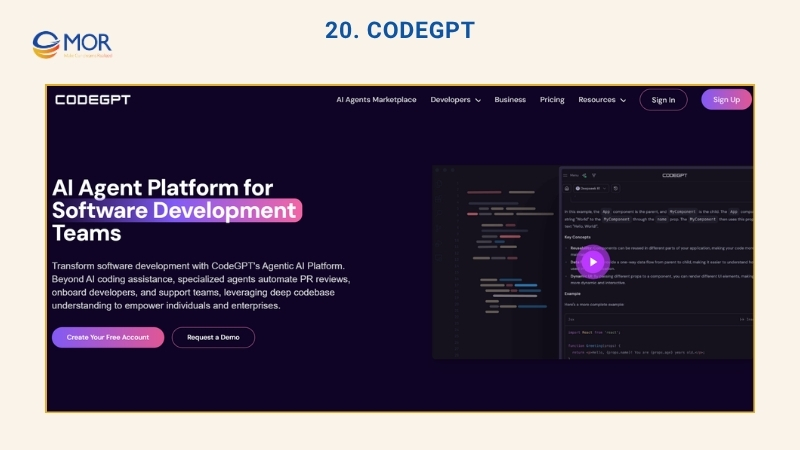
Pros of CodeGPT
- Repository-wide context: Builds an internal knowledge graph of your project, mapping symbols, dependencies, and function calls to provide highly relevant, scoped suggestions.
- Multi-model support: Works with OpenAI, Claude, Gemini, Mistral, and even local models through Ollama, enabling cloud or self-hosted configurations.
- Prebuilt agent library: Offers AI-powered assistants for code review, test generation, documentation, and framework-specific support for tools like Laravel, Supabase, and Next.js.
- Privacy and control: Allows self-hosted and offline inference setups, perfect for organizations handling private or regulated repositories.
- Cross-platform access: Runs inside VS Code, JetBrains IDEs, and Cursor, and also includes a standalone browser-based workspace.
Cons of CodeGPT
Initial setup takes some time, as it involves installing extensions, setting up API keys, and optionally configuring local model servers. The free plan offers limited usage and feature access, and customizing or training new agents requires some understanding of prompt tuning and model architecture.
Our Experience with CodeGPT
We tested CodeGPT while developing an agent-based message loop using a fictional Swarm API. The goal was to create a loop that filtered empty messages and formatted valid ones for console output. The prompt focused on clarifying the logic within a message-processing sequence.
CodeGPT instantly explained how if message["content"] is None: worked with the continue statement to skip irrelevant entries. It also demonstrated the correct use of Python f-strings to log message details while preserving sender information. The inline assistant broke down:
- How conditional statements worked within the loop.
- Why skipping None values improved performance.
- How structured logging ensured accurate sender attribution.
The AI code generation tool didn’t just autocomplete code, it interpreted intent, explained reasoning, and enhanced comprehension directly inside the IDE. This made it particularly useful for onboarding new developers or reviewing unfamiliar codebases where understanding logic matters as much as writing it.
CodeGPT Pricing
- Free: $0/seat/month: basic usage with limited agent features.
- BYOK: $7.20/seat/month (billed annually): “Bring Your Own Key” plan that lifts daily limits and adds advanced planning features.
- Teams: $30/seat/month (billed annually): expands capacity, collaboration tools, and shared context memory.
- For Business: Custom pricing: includes enterprise security, flexible deployments, and dedicated AI agent support.
Expert Take
CodeGPT stands out among AI code generation tools for its balance of explainability, customization, and privacy. The Free plan is ideal for individuals experimenting with AI assistance, while BYOK offers solid flexibility for freelancers or small teams. The Teams and Business plans scale for enterprises that demand deeper integrations and secure deployments. For developers seeking intelligent code interpretation and editor-native automation, CodeGPT delivers an exceptional all-in-one experience.
AI Code Generator Summary And Comparison
From our hands-on experience, AI code generators have reshaped how developers build, test, and maintain software. They do far more than autocomplete, they explain logic, generate tests, detect bugs, and even suggest design improvements. Many integrate directly with IDEs, while others run in the browser or terminal, offering real-time collaboration and automation. Whether you’re an independent developer or part of a large engineering team, there’s a tool that fits your workflow and budget.
Below is a quick comparison of the top tools we’ve covered, highlighting their pricing and standout features.
Tool | Pricing | Key Features |
Qodo | Free for individuals; $19/user/month for teams | Full SDLC coverage, automated code generation, test creation, AI-powered reviews, and seamless multi-IDE integration |
GitHub Copilot | Free for individuals; $4/user/month for teams | Context-aware code suggestions, chat support, multi-language compatibility, and built-in IDE assistance |
Tabnine | Free for basic completions; Pro: $9/user/month | Intelligent code completions, refactoring guidance, auto documentation, and enterprise-level privacy |
Bolt | Free tier; paid plans for added integrations | Browser-native full-stack builder, instant preview, rapid prototyping, and built-in deployment tools |
Amazon Q Developer | Included with AWS plans; usage-based | Secure AWS-native AI code generation, context awareness, and IAM-compliant automation |
AskCodi | Free for individuals; $149.99/year Premium | Code generation, Q&A in natural language, intelligent code suggestions, and IDE integration |
Replit | Free for individuals; $20/month for Core | Real-time suggestions, in-line explanations, debugging assistance, and interactive learning features |
Qwen3-Coder (Unsloth) | Free and open source | Local-first model with massive context window, autonomous AI code generation, and efficient quantization |
OpenAI Codex | Pay-per-use API | Natural language to code, multi-language support, flexible setup, and strong general-purpose capabilities |
Sourcegraph Cody | Free starter; $19–$49/user/month for Enterprise | Context-aware code generation, repository insights, test automation, and LLM flexibility |
DeepCode AI | Free for open source; $5.99/user/month Personal | Security-first hybrid AI, real-time vulnerability detection, and in-line safe code fixes |
Figstack | Free; $9/month Starter | Code explanation, cross-language translation, documentation automation, and Big O complexity analysis |
IntelliCode | Free | GitHub-trained autocompletion, privacy-first local inference, and real-world pattern recommendations |
CodeGeeX | Free; $9/month Pro | Multilingual AI code generation, code translation, comment generation, and integrated AI chatbot |
Cline | Free and open source; $30/user/month Teams | Task-based local coding agent for VS Code, plan-and-approve automation, terminal execution, and snapshot rollback |
Augment Code | Free trial; $50/month Developer | Context indexing, multi-editor integration, memory-based rules, and enterprise-grade compliance |
Gemini CLI | Free tier; $19–$45/user/month | Terminal-based AI code generation with 1M-token context, native tools, and open-source flexibility |
Lovable | Free; $25–$50/month for teams | Browser-based full-stack app builder, natural language prompts, Supabase/Stripe integrations, and visual version control |
CodeGPT | Free; $7–$30/user/month | IDE-integrated AI agent with repo-wide understanding, multi-model support (OpenAI, Claude, Gemini), and local execution options |
Each of these AI code generation tools brings something unique to the table, from local privacy and enterprise compliance to seamless prototyping and IDE-native intelligence. Whether you need a secure, offline model like Qwen3-Coder, or an all-in-one agent ecosystem like CodeGPT, the 2025 lineup of coding AIs proves that developers can now code smarter, faster, and with greater precision than ever.
>>> Many teams still struggle to explain the difference between AI vs ML vs DL, let alone choose the right one for their business. Let's break down each term clearly, compare their real-world applications, and decide which technology fits your goals in 2025.
Key Benefits Of Using AI Code Generators
When teams adopt AI code generation tools across the software development lifecycle, they gain major improvements in speed, focus, and overall efficiency. These tools help automate repetitive tasks, allowing developers to spend more time designing systems, solving complex problems, and refining architecture instead of writing boilerplate code.
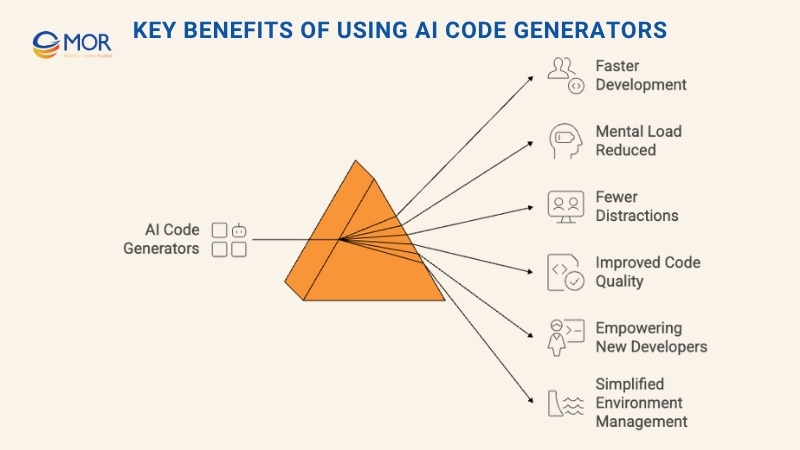
Faster And Smarter Development
AI code generation dramatically shortens development cycles by handling time-consuming, routine work, like writing setup scripts, generating tests, or formatting code. This lets developers concentrate on creative and high-impact tasks.
A GitHub study found that 88% of developers felt more productive when using GitHub Copilot. Developer Rosenkilde shared that “95% of the time, Copilot brings me joy and makes my day a little bit easier. It doesn’t change the logic or the design, it just helps me write the same code faster.”
That sentiment is widespread: according to GitHub’s research, 60% of developers reported feeling more satisfied with their jobs after integrating information sets used in machine learning into their workflow. With the right AI code generator, teams can code faster, stay more engaged, and focus on the work that truly matters.
Reduces Mental Overload
The gains from AI code generation go beyond speed, they also ease the mental strain of repetitive and tedious work. Tasks like debugging often require developers to retrace their steps, sift through long code paths, and test dozens of possibilities before finding the root cause. This process can quickly become exhausting and time-consuming.
As developer Rosenkilde noted, “Sometimes when you’re debugging, you just have to resort to creating print statements that you can’t get around. Thankfully, Copilot is brilliant at print statements.”
That’s part of why 87% of developers say they spend less mental effort on repetitive tasks when using GitHub Copilot. By offloading routine debugging and code review steps to an AI code generator, developers can focus their energy on solving real problems instead of getting bogged down by mechanical, low-value tasks.
Fewer Context Switches
In software development, context switching happens when developers shift between tasks, tools, or projects, breaking their concentration and slowing momentum. Constantly jumping between documentation, enterprise search engine, and different environments can drain focus and reduce productivity.
AI code generation tools minimize that friction. With assistants like GitHub Copilot, developers can stay entirely within their IDE instead of toggling to Google or external docs.
As Rosenkilde explains, “When I’m writing natural language commentary, Copilot’s code completion can help me. Or if I use Copilot Chat, it’s a conversation within the context I’m already in, I don’t have to explain quite as much.”
By keeping all interactions within a single workspace, AI code generators let developers think at a higher level rather than worrying about syntax or low-level details. Berryman adds, “With GitHub Copilot Chat, I don’t have to restate the problem because the code never leaves my trusted environment. I get an answer instantly, and if I need to clarify something, it’s easy to do right there.”
The result: less interruption, smoother focus, and faster progress.
Improved Code Quality
Modern AI code generation tools go beyond speed, they actively help developers write cleaner, safer, and more efficient code. By offering real-time suggestions grounded in industry best practices, these tools flag potential vulnerabilities, highlight design flaws, and recommend performance optimizations before problems escalate.
They can automatically refactor functions for better readability, consistency, and long-term maintainability. They also help prevent common mistakes that often lead to time-consuming bug fixes later in development. The result is code that’s not only error-free but also easier to understand, extend, and maintain across teams.
Helps New Programmers Learn
AI code generation tools make software development far more approachable for beginners. They offer real-time guidance, contextual code examples, and clear explanations that help new programmers understand unfamiliar languages and adapt to new projects faster.
These tools can:
- Generate functional code directly from plain-language prompts.
- Explain existing code so learners grasp how and why it works.
- Provide step-by-step guidance for complex programming tasks.
- Review written code and suggest improvements in structure or style.
Beyond training new developers, AI code generators also help non-technical team members participate in the process. Business users can describe desired features or issues in simple language, then use AI-generated code snippets to communicate requirements clearly to developers. This bridges the gap between technical and non-technical teams, making collaboration smoother and development cycles more efficient.
Handles Code Environments
Writing code is just one piece of the development puzzle. Running that code reliably requires the right setup, complete with configurations, libraries, and dependencies. Developers often juggle multiple environments for building, testing, and production, which can be tedious and error-prone.
Modern AI code generation tools help streamline this process. They don’t just write code, they manage environments, automate setup, and ensure compatibility across stages of the development pipeline. From configuration handling to deployment optimization, these tools bring efficiency and consistency to every step of the software lifecycle.
Evaluating AI Code Generators For Enterprise Teams
Each of these tools brings something unique to the table, from real-time code assistance to full-stack automation and intelligent debugging. Let’s take a closer look at how they’re shaping the future of AI code generation in 2025.
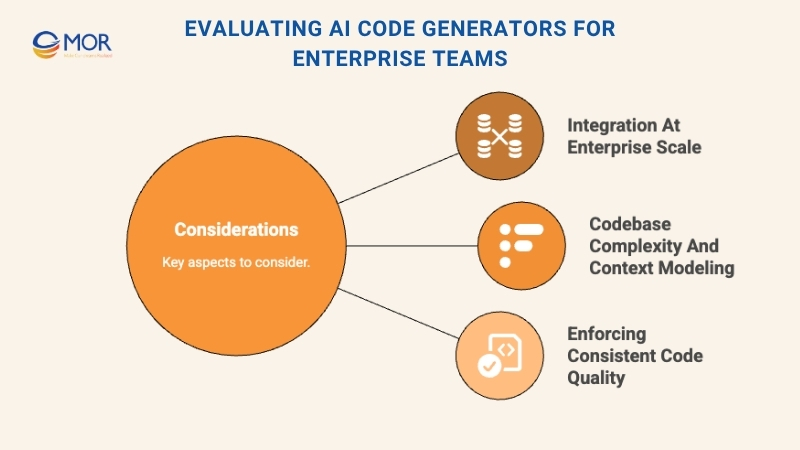
Integration With Large-Scale Systems
For large organizations, AI code generation and review platforms must integrate smoothly across the entire development ecosystem. At the enterprise level, success isn’t about having the most features, it’s about how well the tool aligns with existing workflows without adding friction. Too many solutions still push developers into browser-based environments or command-line interfaces, interrupting productivity and creating unnecessary bottlenecks.
An enterprise-ready platform should plug directly into GitHub, GitLab, or Bitbucket, while also integrating with CI/CD pipelines to automate quality checks within both IDEs and pull requests. Compatibility with task management tools like Jira or Linear is equally important, ensuring traceability across coding, testing, and deployment. Tools like Qodo take this a step further by embedding AI-powered agents inside IDEs, pull requests, and pipelines, allowing teams to review and refine code effortlessly without disrupting their established development flow.
Understanding Complex Codebases
Enterprise-scale projects come with complex architectures, often monorepos or multi-repos that span multiple frameworks, languages, and interconnected services. In these environments, lightweight AI code generation tools tend to fall short. Their limited context windows and shallow understanding of dependencies make it difficult to capture the full picture of how systems interact.
An enterprise-ready platform must go further. It should identify internal libraries, learn from commit histories, and reason across repositories as a built-in function, not an afterthought. Qodo approaches this challenge with an organization-wide context model that blends several indexing methods. Its intelligent agents use this model to understand relationships between services and repositories, enabling more accurate reviews and minimizing regressions across dependent components.
Enforcing Code Standards
Maintaining consistent quality across large, distributed teams is one of the toughest challenges in enterprise development. Manual reviews often vary in depth and rigor, leading to uneven results. The solution lies in automation, using AI code generation and review systems that enforce coding standards, security rules, and testing policies without depending solely on human oversight. These platforms should also provide structured, explainable fixes so developers understand both the issue and its resolution.
Comprehensive test generation and validation are just as critical for maintaining healthy coverage over time. Qodo addresses this with a multi-agent system: one agent focuses on code creation, another handles testing, a third enforces compliance, and a fourth conducts structured reviews. By embedding automated quality checks throughout the development lifecycle, Qodo ensures consistent, policy-driven results and removes the need for fragmented, manual review processes.
MOR Software: Your Trusted Partner In AI Code Generator Development
At MOR Software, we help businesses apply AI code generation to real-world projects. Our team builds smart, scalable development tools that integrate AI into your existing workflow, from code automation to continuous integration.
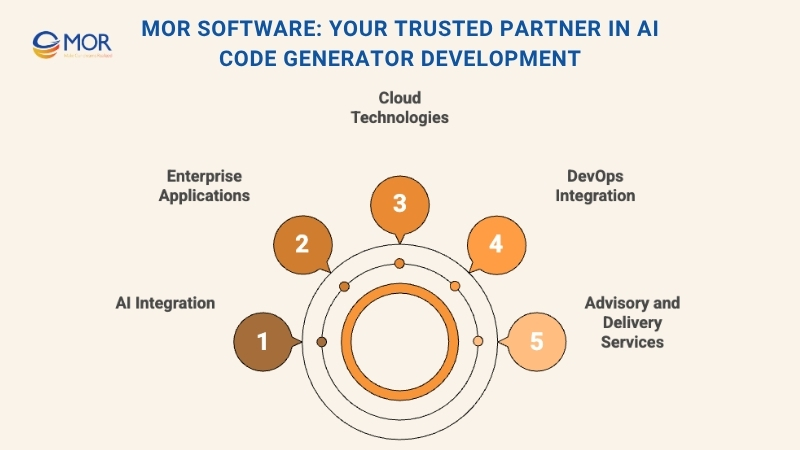
As a top software outsourcing development company in Vietnam, we have deep experience in building AI-based systems, enterprise AI solutions, and intelligent automation platforms. Our developers work with the latest technologies, like OpenAI, AWS, and Google Cloud, to create secure, high-performance solutions tailored to each client’s goals.
Whether you’re exploring AI-powered software development or want to integrate an AI code generator into your DevOps process, we can help you move faster with confidence and precision.
Contact us to learn how our AI outsourcing development expertise can accelerate your next project.
Conclusion
AI code generator is reshaping how teams develop, test, and maintain software, making every stage of the process faster, smarter, and more consistent. From automating reviews to improving code quality, these tools empower developers to focus on innovation instead of routine tasks. With MOR Software’s proven expertise in AI-powered development, you can confidently integrate intelligent automation into your projects. Contact us today to transform your software development process with AI.
MOR SOFTWARE
Frequently Asked Questions (FAQs)
What is an AI code generator?
An AI code generator is a tool that turns natural-language descriptions into real, working code. It uses advanced language models trained on massive datasets of programming examples to write scripts, components, or entire applications automatically.
How does an AI code generator work?
It analyzes your text prompt using natural language processing (NLP), understands your intent, and produces relevant code. Some tools also look at your existing files to keep the output consistent with your project.
What programming languages do AI code generators support?
Most modern tools support widely used languages like Python, JavaScript, TypeScript, Java, C++, C#, PHP, and Go. Advanced platforms like GitHub Copilot and CodeGPT can also handle frameworks such as React, Django, or Node.js.
Are AI code generators accurate?
They’re generally accurate for common coding tasks but still need human review. The output might contain syntax errors or inefficient logic, so testing and debugging are essential before deployment.
Can an AI code generator replace human developers?
No. It automates repetitive or boilerplate coding, but it can’t replace a developer’s creativity, design judgment, or architectural planning. Think of it as a coding assistant, not a substitute.
What are the main benefits of using an AI code generator?
It helps you save time, reduce manual errors, and increase productivity. It can also explain code, suggest improvements, and speed up testing and documentation.
Is the code created by AI safe and secure?
It depends on the provider and your workflow. Enterprise-grade generators like DeepCode AI and Qodo follow strict compliance standards, but you should always perform manual code reviews and security scans.
Do AI code generators work offline?
Some tools, such as Qwen3-Coder (Unsloth) and Cline, can run locally without an internet connection. Most others, including Copilot and Tabnine, rely on cloud-based models and require connectivity.
Are AI code generators suitable for beginners?
Yes. They’re helpful for learning syntax, exploring frameworks, and understanding coding patterns. Many tools can explain the generated code, making them ideal for training or self-study.
Can AI code generators help with debugging?
Yes. Many come with debugging support or code review options. Tools like Replit, Tabnine, and Qodo can detect issues, suggest fixes, and even write unit tests to validate logic.
How much do AI code generators cost?
Pricing depends on the tool. Free versions usually include limited credits or features, while premium plans range from $9 to $50 per month. Enterprise options include advanced integrations and data privacy controls.
Which AI code generator is best in 2025?
It depends on your needs. GitHub Copilot and Amazon Q Developer are great for cloud workflows, Qodo and Sourcegraph Cody work best for enterprises, and Qwen3-Coder (Unsloth) is ideal for open-source or offline projects.
Rate this article
0
over 5.0 based on 0 reviews
Your rating on this news:
Name
*Email
*Write your comment
*Send your comment
1